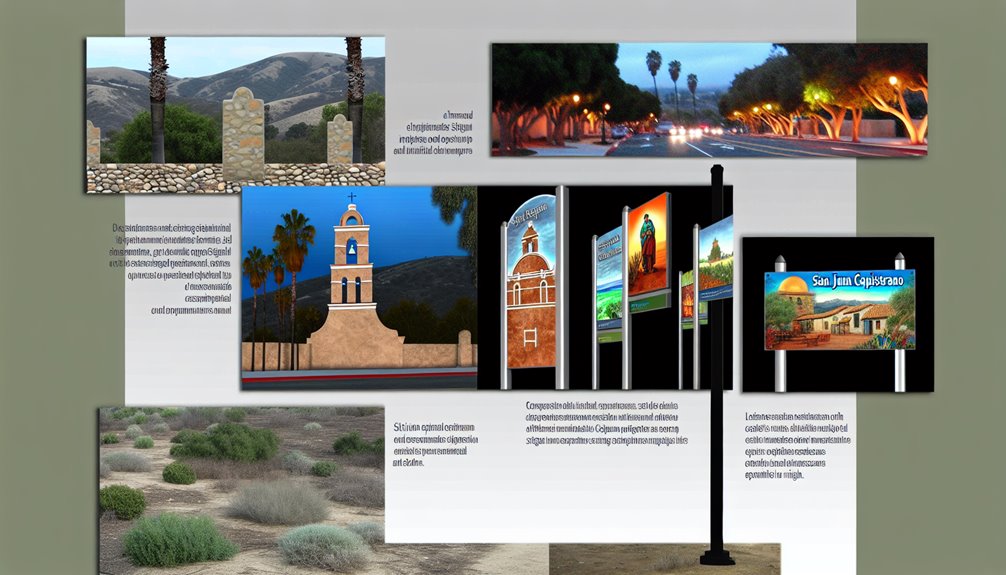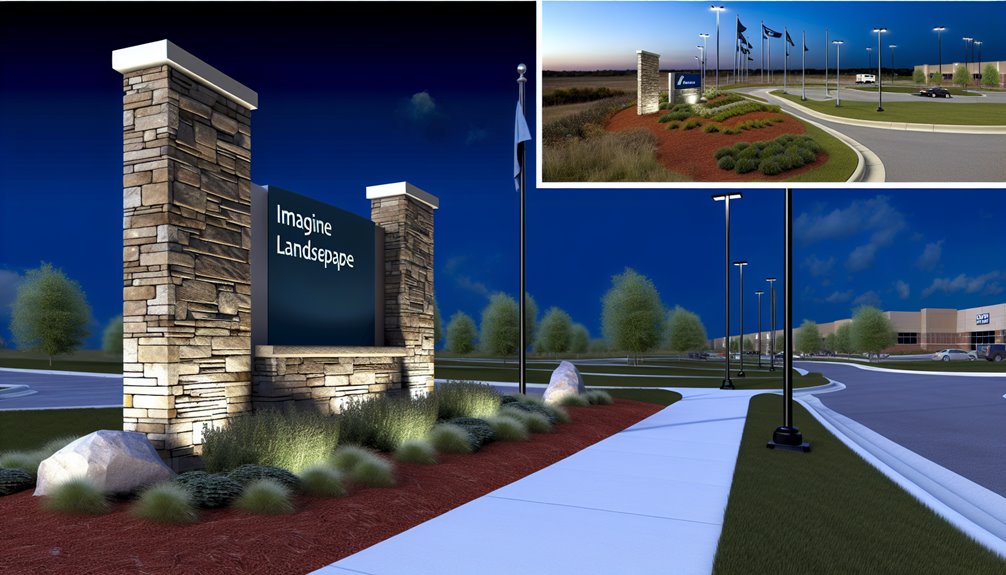In San Juan Capistrano, illuminated monument signs aren't just functional; they're pivotal in shaping the night-time ambience and aiding navigation through our beautiful city. These signs blend durability, provided by materials like high-density urethane and aluminum, with advanced technology such as LED lighting, maximizing visibility and energy efficiency. Adhering to local regulations that balance business visibility with aesthetic concerns, these signs respect our unique city character while enhancing overall urban design. We've seen how they transform public spaces, inviting both locals and visitors to engage more deeply with their surroundings. Continued exploration will reveal even more about their impact on our community.
History of Illuminated Signs
Throughout history, illuminated signs have revolutionized the way businesses attract attention. Their historical significance is profound, marking eras of commercial innovation and cultural shifts. As we explore their origins, we see how these luminous beacons haven't only directed customers but also shaped the visual identity of commerce itself.
Illuminated signage first made its mark in the early 20th century. As electricity became more accessible, businesses harnessed this new technology to stand out in bustling streets. The bright glow of neon, in particular, became synonymous with progress and modernity. Cities like Las Vegas and Times Square turned into iconic landscapes, largely due to their elaborate electric signs.
The cultural influence of these signs can't be overstated. They've been immortalized in film, literature, and photography, symbolizing both the allure and the pitfalls of capitalist societies. They speak to both the ingenuity of marketers and the evolving tastes of consumers, reflecting society's values and economic conditions.
Understanding the evolution of illuminated signs helps us appreciate their role in shaping our environmental and cultural landscape. They're not just tools of advertisement; they're integral elements of public space that narrate the story of commerce and culture. The introduction of neon signs in the 1920s marked a significant technological advancement, enhancing the nighttime visibility and aesthetic appeal of business facades.
Importance in Urban Design
Illuminated signs play an essential role in urban design, shaping the way cities are perceived and navigated. By integrating these vibrant markers into the cityscape, we're not just enhancing visibility; we're also enriching the urban aesthetics that define the character of a place.
These signs act as landmarks, guiding residents and visitors alike through the urban environment with ease and confidence.
Consider the cultural significance these illuminated signs hold. They often embody the identity of a neighborhood, reflecting its history and ethos. In places like San Juan Capistrano, where tradition meets contemporary needs, these signs are pivotal in bridging past and present.
They offer a narrative element to the city, telling stories through their designs and the strategic locations they occupy.
Moreover, the way these signs blend into the urban landscape influences how people interact with the spaces around them. A well-placed, artistically designed sign not only directs flow but also enhances the aesthetic appeal of the area, encouraging people to stop, admire, and engage with the environment.
It's these subtle yet significant touches that add depth to our urban experience, making illuminated signs indispensable in thoughtful urban planning.
Modern illuminated signs utilize LED technology, which offers energy efficiency and vibrant display options, aligning with contemporary environmental and aesthetic standards in urban design.
Materials and Construction
In constructing these monument signs, we prioritize durability and visual appeal by selecting high-quality materials. We recognize the importance of a sign that not only stands out but also withstands the test of time and elements. That's why we opt for materials like high-density urethane and aluminum, known for their resilience and ability to maintain luster.
Our construction techniques are tailored to guarantee that these durable materials are utilized to their fullest potential. We employ precise fabrication methods, including laser cutting and CNC routing, which allow for meticulous detail and accuracy in design. This guarantees that each element of the sign is crafted with precision, contributing to both its aesthetic quality and structural integrity.
Moreover, we're committed to a seamless assembly process. By integrating strong, weather-resistant adhesives and modern fastening methods, we assure that our signs aren't only visually appealing but also robust and secure. The choice of materials and the attention to detail in construction reflect our dedication to providing signs that serve as lasting landmarks.
We're here to make certain that every aspect of your monument sign project is handled with expertise, from the initial design to the final installation, ensuring a product that truly stands the test of time.
To support this commitment, our team continuously seeks innovative techniques to better serve clients, ensuring that the functionality and aesthetic appeal of our monument signs meet the highest standards of quality and innovation.
Technological Advancements
How have recent technological advancements transformed the way we design and produce monument signs? We've seen a significant shift, primarily driven by LED innovation and the emergence of smart signage.
These technologies not only enhance the visual appeal of signs but also improve their functionality and energy efficiency.
LEDs have revolutionized monument signs by offering vibrant, long-lasting illumination that's incredibly energy-efficient compared to traditional lighting solutions. This leap in technology allows us to create signs that aren't only more eye-catching but also more sustainable.
We're no longer bound by the limitations of older lighting techniques, which means our creative possibilities have expanded tremendously.
Smart signage represents another groundbreaking development. These signs can interact with mobile devices, adjust their brightness based on ambient light conditions, and even gather data to optimize their performance.
This level of interactivity provides an unmatched user experience and allows businesses to engage directly with their audience in real-time.
Together, these advancements enable us to offer you state-of-the-art monument signs that stand out and deliver messages effectively.
They're not just signs; they're smart business tools that adapt and respond to the environment, ensuring maximum impact and engagement.
We're excited to bring these innovative solutions to your next project.
Incorporating modern LED technology provides signs with unmatched clarity and visibility, making them effective both day and night.
Local Regulations Impact
Local regulations greatly shape the design and installation of monument signs. We must navigate through a web of local zoning laws and obtain the necessary sign permits before bringing our vision to life. These regulations guarantee that signs are aesthetically pleasing and harmonious with San Juan Capistrano's historic and cultural ethos.
Navigating local zoning involves understanding specific constraints on sign dimensions, lighting, and placement. These rules aren't just bureaucratic hurdles; they're crafted to maintain the town's visual integrity and safety standards. For instance, a sign that's too large or brightly lit could distract drivers or clash with our city's quaint, mission-style architecture.
Securing sign permits is another critical step. This process verifies that our proposed signs meet all local standards, from structural safety to environmental compliance. It's essential we stay proactive in this area to avoid costly redesigns or delays. The permitting process might seem intimidating, but it's a necessary safeguard that maintains the quality and consistency of our community's visual landscape.
We're committed to guaranteeing our illuminated monument signs not only capture attention but also respect and enhance the local environment. By adhering to these regulations, we help preserve the unique charm of San Juan Capistrano while promoting our businesses effectively. Adhering to ADA standards in signage ensures accessibility and inclusivity, reflecting our community's commitment to welcoming all visitors and residents.
Installation and Maintenance
Once we've navigated the regulatory hurdles, our team's focus shifts to the precise installation and diligent maintenance of monument signs.
We're committed to employing advanced installation techniques that guarantee not only the structural integrity but also the aesthetic alignment of each sign with its surrounding environment. This involves a meticulous process where every detail, from the depth of the foundation to the positioning of lighting elements, is carefully considered and executed.
Maintaining these signs is equally vital. We've developed extensive maintenance schedules that are tailored to the needs of each sign, considering factors like local climate conditions and the specific materials used.
Regular inspections are a key component of our maintenance plan, aimed at identifying potential issues before they escalate. This proactive approach helps in extending the lifespan of the signs and preserving their visual appeal.
We understand that the longevity and effectiveness of a monument sign greatly depend on these practices.
That's why we're here to guide you through every step—guaranteeing that your investment not only meets but exceeds expectations.
Let's work together to make your sign a lasting landmark.
Case Studies and Examples
We've successfully implemented monument signs across various locations, each project demonstrating our commitment to excellence and meticulous attention to detail.
Let's explore a few case studies that stand out, showcasing our innovative design concepts and strategic branding strategies.
In the heart of San Juan Capistrano, we designed a monument sign for a newly established boutique. The challenge was to reflect the store's unique character while enhancing brand visibility. Our solution was a sleek, modern design with integrated LED lighting that not only captured the boutique's essence but also made it a landmark.
Another project involved a tech startup looking for a sign that embodied innovation. We incorporated dynamic digital display panels into the monument structure, allowing the company to change messages seamlessly and interact with its audience in real-time.
This adaptability in design fortified their branding strategy, making it not just seen but interactive.
Each case study reflects our dedication to not just meeting but exceeding client expectations. By focusing on tailored solutions that align with specific branding needs, we guarantee that each monument sign isn't only a marker but a messenger of the brand it represents.
Frequently Asked Questions
How Do Illuminated Signs Affect Bird Migration in San Juan Capistrano?
We've found that illuminated signs contribute greatly to light pollution, which can disrupt bird migration patterns. Understanding and mitigating these effects is essential for preserving natural wildlife behavior in urban environments.
Are Solar-Powered Options Available for Illuminated Signs?
We've discovered solar-powered options that not only reduce sign maintenance but also harness solar energy efficiently. This sustainable choice meets your mastery goals by aligning with eco-friendly practices and long-term cost savings.
Can Illuminated Signs Be Customized for Small Businesses?
Yes, we can customize illuminated signs to fit the unique needs of small businesses. These custom design options offer significant visibility benefits, helping your business stand out and attract more customers effectively.
What Are the Energy Costs Associated With Running Illuminated Signs?
We've found that the energy costs of running illuminated signs vary widely based on their energy efficiency. A thorough cost analysis is essential to understand the ongoing expenses involved in their operation.
How Do Illuminated Signs Impact Nighttime Driving Safety?
We've found that illuminated signs can enhance nighttime visibility and driver awareness, making roads safer. They alert drivers to upcoming locations and hazards, reducing the risk of accidents during low-light conditions.






